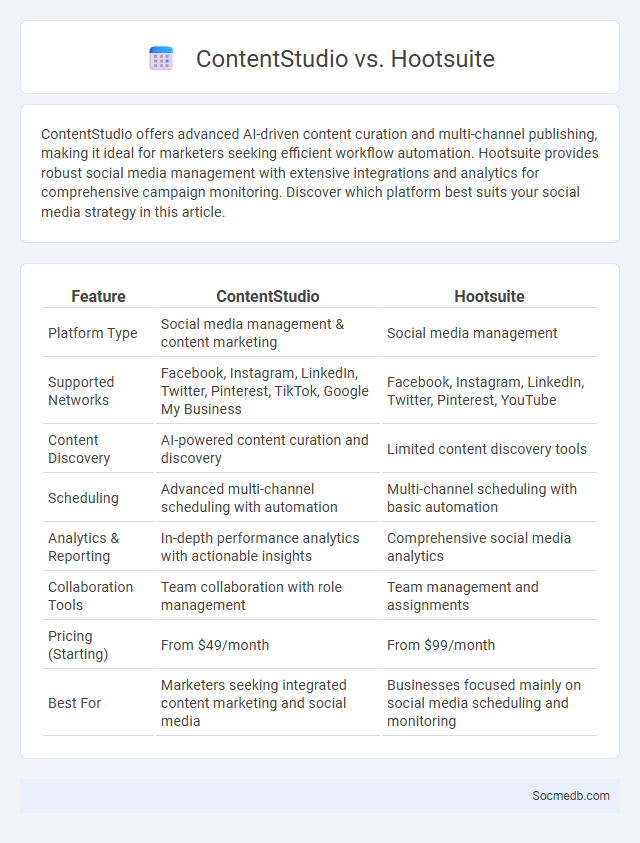
Photo illustration: ContentStudio vs Hootsuite
ContentStudio offers advanced AI-driven content curation and multi-channel publishing, making it ideal for marketers seeking efficient workflow automation. Hootsuite provides robust social media management with extensive integrations and analytics for comprehensive campaign monitoring. Discover which platform best suits your social media strategy in this article.
Table of Comparison
| Feature | ContentStudio | Hootsuite |
|---|---|---|
| Platform Type | Social media management & content marketing | Social media management |
| Supported Networks | Facebook, Instagram, LinkedIn, Twitter, Pinterest, TikTok, Google My Business | Facebook, Instagram, LinkedIn, Twitter, Pinterest, YouTube |
| Content Discovery | AI-powered content curation and discovery | Limited content discovery tools |
| Scheduling | Advanced multi-channel scheduling with automation | Multi-channel scheduling with basic automation |
| Analytics & Reporting | In-depth performance analytics with actionable insights | Comprehensive social media analytics |
| Collaboration Tools | Team collaboration with role management | Team management and assignments |
| Pricing (Starting) | From $49/month | From $99/month |
| Best For | Marketers seeking integrated content marketing and social media | Businesses focused mainly on social media scheduling and monitoring |
Overview: ContentStudio, Hootsuite, and Content Curation
ContentStudio and Hootsuite are leading social media management platforms that streamline scheduling, analytics, and engagement across multiple networks. Content curation within these tools enhances audience targeting by efficiently sourcing and sharing relevant industry content to boost brand credibility and interaction. Leveraging advanced algorithms, both platforms facilitate automated content discovery and real-time performance tracking to optimize social media campaigns.
Key Features Comparison
Social media platforms offer diverse key features tailored to user engagement, such as Facebook's extensive networking tools and Groups functionality, Instagram's visual storytelling with Stories and Reels, and Twitter's real-time news sharing via Tweets and Threads. Each platform integrates unique algorithms to prioritize content visibility, with TikTok emphasizing short-form video discovery through personalized For You pages and LinkedIn focusing on professional networking with robust job posting and networking features. Understanding these core distinctions helps businesses and individuals choose the optimal platform for targeted audience interaction and content strategy.
Ease of Use and User Interface
Social media platforms prioritize ease of use by integrating intuitive navigation and streamlined features that accommodate users of all technical levels. A clean and responsive user interface enhances engagement by minimizing clutter and ensuring fast access to core functions such as posting, messaging, and notifications. Continuous updates based on user feedback refine the interaction experience, reinforcing platform accessibility and user satisfaction.
Supported Social Media Platforms
Supported social media platforms include major networks such as Facebook, Instagram, Twitter, LinkedIn, TikTok, and Pinterest, enabling diverse audience engagement and targeted marketing strategies. Integration with these platforms facilitates content sharing, user interaction, and analytics tracking for enhanced campaign performance. Businesses leveraging supported social media platforms benefit from expanded reach, improved brand awareness, and data-driven decision-making.
Content Curation Capabilities
Content curation capabilities on social media enable you to efficiently gather, organize, and share relevant information that resonates with your target audience, enhancing engagement and brand authority. Advanced algorithms and AI-driven tools analyze trends and user preferences to streamline the selection of high-quality content, ensuring your feed remains dynamic and informative. Leveraging these capabilities boosts your digital presence by maintaining consistent posts that foster community interaction and drive organic growth.
Automation and Scheduling Tools
Automation and scheduling tools in social media streamline content management by allowing users to plan and publish posts across multiple platforms at optimal times. These tools enhance engagement rates and maintain consistent brand presence by leveraging analytics to identify peak audience activity. Popular solutions such as Hootsuite, Buffer, and Sprout Social integrate AI-driven features to optimize post timing and automate repetitive tasks, saving time and improving overall social media strategy efficiency.
Analytics and Reporting Functions
Social media analytics and reporting functions empower you to track key performance indicators such as engagement rates, click-through rates, and audience demographics in real time. Advanced tools utilize machine learning algorithms to provide actionable insights from complex data sets, enabling precise campaign optimization. Consistently analyzing these metrics ensures your social media strategy aligns with business goals and improves return on investment.
Pricing and Subscription Plans
Social media platforms offer a range of pricing and subscription plans tailored to different user needs, from free basic accounts to premium tiers with advanced features. Platforms like LinkedIn Premium provide subscription options starting at $29.99 per month, unlocking tools for networking and job searching. Instagram and Facebook mainly rely on advertising revenue, offering no subscription fees but monetizing via targeted ads and business accounts.
Pros and Cons of Each Solution
Social media platforms like Facebook, Instagram, Twitter, and LinkedIn each offer distinct advantages and drawbacks. Facebook excels in community building and targeted advertising but can raise privacy concerns and spread misinformation. Instagram boosts visual engagement and brand identity yet may foster unrealistic beauty standards and algorithmic content biases, while Twitter is effective for real-time news and public discourse but often struggles with harassment and misinformation. LinkedIn provides professional networking and job opportunities but may limit creative expression and diversity of content.
Which Platform is Best for Your Content Strategy?
Choosing the best social media platform for your content strategy depends on factors such as your target audience, content type, and brand goals. Instagram excels in visual storytelling with strong engagement for lifestyle and e-commerce brands, while LinkedIn is ideal for B2B marketing and professional content. TikTok offers rapid growth opportunities for short-form video content targeting younger demographics, and Facebook provides broad reach with versatile content options and advertising tools.
 socmedb.com
socmedb.com